Mathematics and Art

Current MAM Home Page || Previous MAWs/MAMs || Current Activities




The Geometry of the Circle, Square and Heart
Acrylic on Plexiglas - ©1996.
I have taken a historical perspective in my art works to represent and reflect geometries throughout time. Invariably, in this methodology, much of what is integrated into my work has a strong historical foundation in the classical construction methods of the ancient Greek geometers. As I research and integrate into the work, more complex elements of the natural world, such as the structures and color usages, coexist within the realm of these properties. Geometrical mechanics and constructions with color form the fundamental components in the building process of my work. Geometry is thus defined in pictorial space.
Someone asked me recently, why I decided to take a geometric approach in my works of art. My answer was that this approach has a clear, universal, and strong foundation, and is therefore readily understood and comprehended. In this vocabulary of nature, from the paths of subatomic particles in cloud chambers and accelerators, to the orbits of the planets, galaxies, and other heavenly bodies, draw relationships to my work.
It is without a doubt, correct to say that there is a particular vocabulary constructed from geometric elements that is used consistently throughout my work. Basically, my work consists of color fields, lines (converging, diverging, parallel, or approaching asymptotically), circles, ellipses, hyperbolas, and many of the other classical curves of ancient and modern mathematics. It matters not whether they are considered as conic sections, Euclidean constructions, or the solutions for systems of differential equations. I consider each composition or completed construction, using these elements, as a singular artistic expression. Thus, I use geometry as a language to engineer my aesthetic expressions.
There is a strong personal identity and style in my work. In making design choices, there is no uncertainty in the choice of geometrical signing that originate from the vocabulary of geometry. There is a complete union between the aesthetic and the geometric signing. What follows below in the paper, will describe more completely how and why it is that this comes about. I am constantly trying to break new ground by integrating new elements into my work; often the completed work leaves the impression that these solutions were simple or easy. The organization to completion is often enormously awkward and difficult though faced with the need and desire to introduce new and changing elements in my work, I have found that my methods of construction have remained constant. I have devised my own algorithmic constructive procedures to draw the cardioids, tricuspoids, parabolas, strophoids, pseudospheres, and other figures I require in my work.
Collinearity (of a set of points lying in the same straight line), a recurrent theme, is never coincidental but is an inevitable outcome, forced in the same way that it occurs in the classical Theorems of projective geometry, such as those of Pascal, Brianchon, Desargues, and others. These mathematicians recognized that spatial situations which produce collinearity were invariably the result of deep underlying geometric truths. The incidence of a point on a line is invariant under the projective rules. If three or more points are collinear along a line, then incident with a straight line, the images will thus be collinear. Therefore, the characteristics of incidence, collinearity, and concurrence are principle requisites of my work.
Intersections of lines or curves in my work are occurrences of fundamental importance. A place of intersection where three or more lines meet or cross, is an especially crucial event in my work and forms an integral part of my above mentioned geometric vocabulary. In this system, the perpendicular intersection of two lines is interchangeable with the three- line intersection. It is not the aim to provide a subdivision and dissection of space, but to represent space as a complex unity.
Geometrical rules, axioms, methods, and carefully thought out plans enter the world on many levels. The geometrical method lends much to the imaginative and creative faculties of people, and has provided a sustained interest and impetus for me in particular. Many of the elements, straight lines, arcs, elliptical sections, parabolas, hyperbolas, epicycloids, and spirals, accelerate the speed of the viewer's eye through the picture, thus spatial experience is altered in time. Color vibration heightens the speed and expanse for the viewer to complete the picture plane. Within the constraints of geometric mechanics, I have built through the intersection of geometric systems, a way of representing the dynamics of motion, gravitational attraction, flotation, and corpuscular unity. This provides the viewers with visual instruments which they may consider proportionately in relation to themselves and in the image. In this respect, I look to this pictorial vision so that the final result is raised through the perception and understanding of the viewer. An image mathematically abstract in origin and represented as nonobjective in context will change experientially through the picture plane, enabling the viewers' apperception and organization of mind set.
Positive and negative curvature of line, whether all inward or all outward are aesthetic choices combined with reason. It is the idea complex that reaches the positive and negative ranges in the approach. Although the work may seem to have little direct human or emotional content (in the most superficial sense), there are metaphors and connections to the human condition in the various dynamical paths of particles and objects to which we are all subject to. Thus, a hyperbolic trajectory, in the context of Newtonian mechanics, is associated with the freedom and escape from the attraction of a massive and ponderous object. An ellipse or circle, in the same classical Newtonian framework, is the solution which results in stable mutually orbiting systems, as in a marriage, coupling, or a stable cultural system. The parabola, discovered long ago and defined as a conic section or locus, is a solution of the same set of differential equations, and represents a falling back to earth of a massive object unable to reach escape velocity, Icarus in his flight to the sun.
These themes could be expressed more literally, but it is my method to create images of contemplation and thought. So, the viewer experiencing my work, visually is subject to the same universal and impersonal truths, whether the solutions of differential equations with differing initial conditions are known. As it is, they are bound within the light cones of Minkowski space, whose intersections with planes yield the same conic sections of the ancient sage Apollonius.
Within a brief time span in the great arena of geometers, we tend to navigate from one geometrical theme to the next. However, there has not yet been a complete integration of all the phases of these monumental works, spanning time from Pythagoras, through Kepler and Newton, and on to Bolyai, Lobachevskii, Riemann, Minkowski, and Einstein. Most have documented individual systems of modeling along established aphorism. For these geometric abstractions in art, my goal is to work with a pure integration of geometry by incorporating elements from Euclidean and non-Euclidean hyperbolic space simultaneously with complete interchangeabilty and superposition.
From slow curves to accelerated curves, interlocked with straight lines of infinite speed (as the photon is thought to be, could it have it's own rest frame), they are the elements of natural law I have chosen for my visual language. The elements of Pythagorean geometry underly the structuring for a non-Euclidean space, thus, revealing a perspective on present time. Through subliminal effect in hidden ordering, that which is integral to the space, demonstrates an independent and singular theme for the picture.
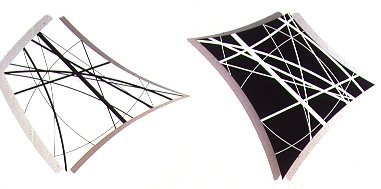
Portals
Acrylic on Wood - ©1987.
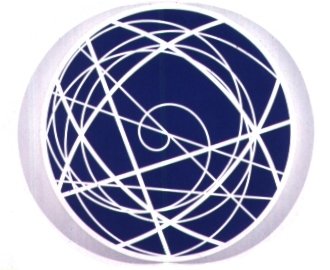
Universe
Acrylic on Canvas, 28 inches diameter - ©1992.
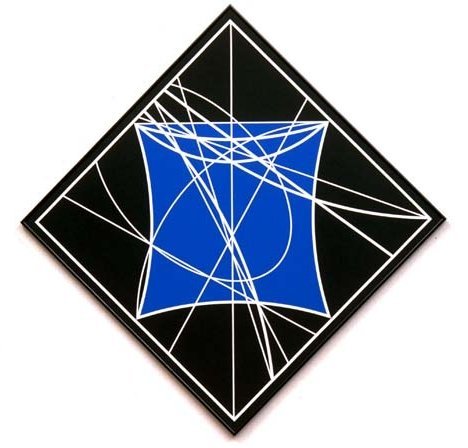
Black Diamond
Acrylic on Plexiglas, 41.5 x 41.5 inches - ©1996.
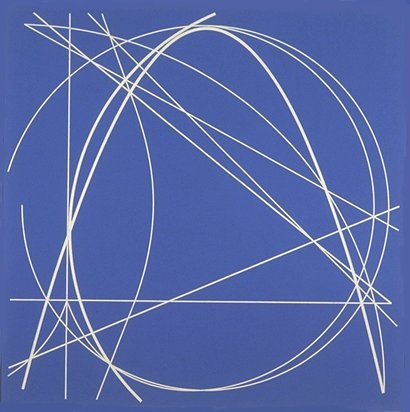
Millennium
Acrylic on Plexiglas, 36 x 36 inches - ©1997.

Half Sphere with Shadow
Acrylic on Plexiglas, 36 x 36 inches - ©1997.
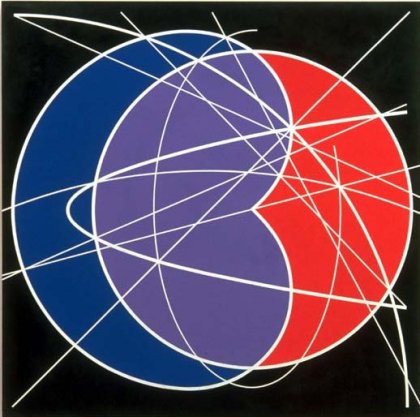
Limacon
Acrylic on Plexiglas, 36 x 36 inches - ©1997-1998.
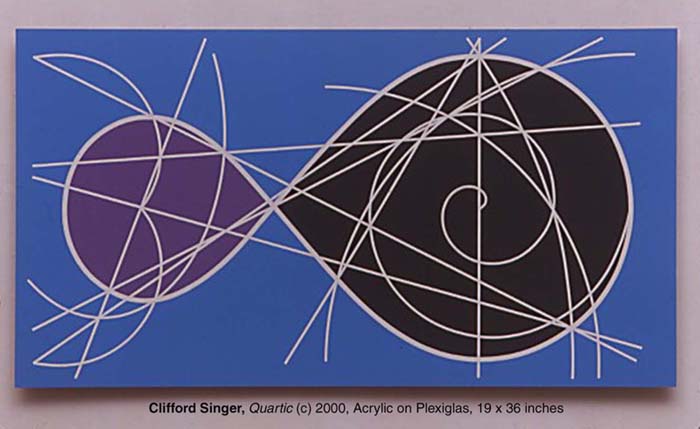
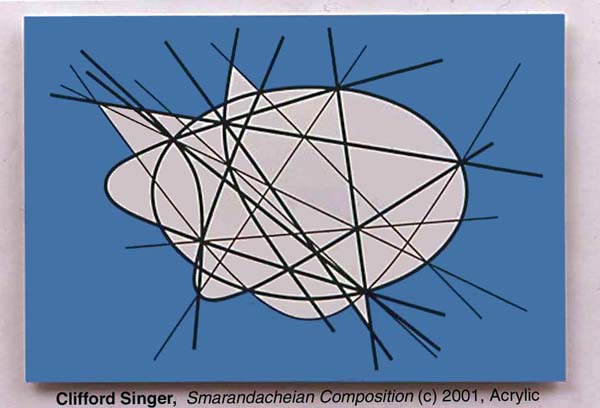
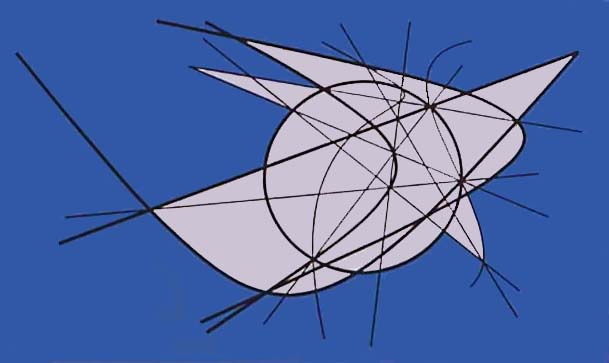
Clifford Singer, The Blue Rider ©2001, Acrylic on Plexiglas, 25 x 42 inches
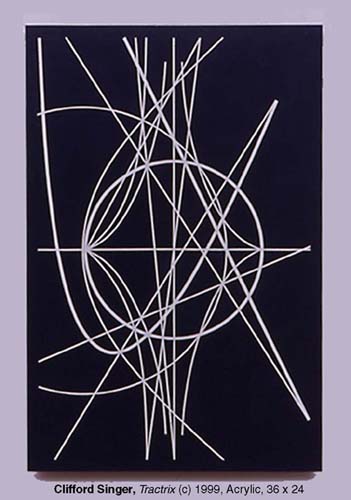
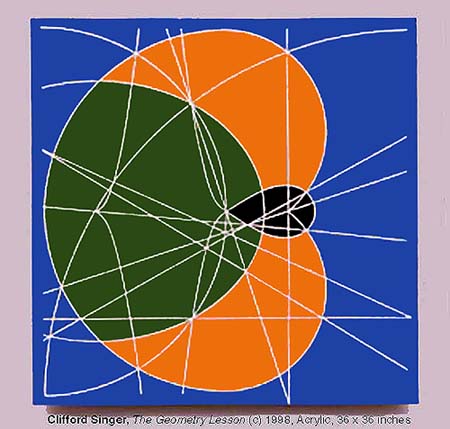
| Mathematics Awareness Month is sponsored each year by the Joint Policy Board for Mathematics to recognize the importance of mathematics through written materials and an accompanying poster that highlight mathematical developments and applications in a particular area. |